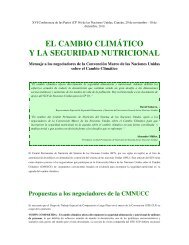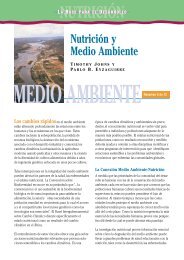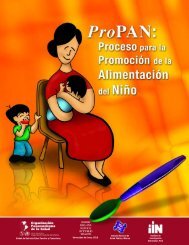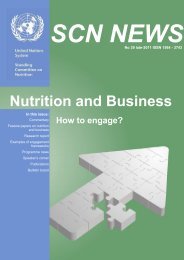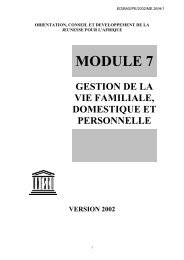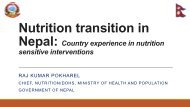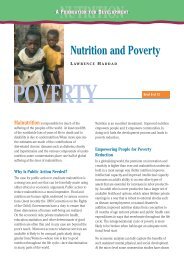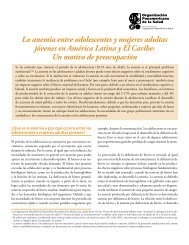SCN News No 36 - UNSCN
SCN News No 36 - UNSCN
SCN News No 36 - UNSCN
Create successful ePaper yourself
Turn your PDF publications into a flip-book with our unique Google optimized e-Paper software.
www.unsystem.org/scn FEATURES 21<br />
Addressing the underlying determinants of undernutrition:<br />
Examples of successful integration of nutrition in poverty-reduction and agriculture strategies<br />
Marie T. Ruel, Director, Food Consumption and Nutrition Division, International Food Policy Research Institute (IFPRI)<br />
Introduction<br />
The third paper of the Lancet Series on Maternal and Child Undernutrition argues that effective, targeted<br />
nutrition interventions exist; and that if implemented at scale during the window of opportunity (pregnancy and<br />
up to the child’s second birthday), these interventions could reduce undernutrition-related mortality and<br />
disease burden by 25% in the short term (Bhutta et al 2008). The set of interventions recommended<br />
addresses mainly the “food” (and nutrient) intake needs of mothers and children because this is where most<br />
of the quantitative evidence of efficacy and effectiveness lies. Interventions to directly improve health and<br />
care – the other two proximal determinants of undernutrition - are largely absent from the discussion, as are<br />
interventions targeting the more distal, underlying determinants of undernutrition such as poverty, food<br />
insecurity and lack of education. These omissions are justified, given the dearth of quantitative data on the<br />
effectiveness of interventions aimed at improving the underlying determinants of malnutrition. Examples of<br />
such programme and policy actions include strategies to reduce poverty, empower women and reduce<br />
gender inequality; agriculture development approaches to increase food production, income and food security<br />
and to stimulate overall economic growth; education to build human capital and empower future generations;<br />
and health systems strengthening to achieve high-quality health coverage for all. The Lancet Series’ review<br />
of interventions also applies an additive model, which assumes that interventions act independently of one<br />
another. <strong>No</strong> allowance is given for interventions implemented jointly with the possibility of interactive,<br />
synergistic effects on improving nutrition, health and education, or for integrated packages of interventions<br />
that simultaneously address the direct and underlying determinants of nutrition.<br />
This paper highlights the importance of addressing the global context in which undernutrition occurs, and<br />
argues that significant and sustained progress in improving maternal and child nutrition cannot be achieved<br />
unless appropriate actions are put in place to address the underlying determinants of undernutrition. The<br />
paper also emphasizes the importance of using a life-cycle approach to address undernutrition. While the<br />
nutrition community has finally reached a consensus on the importance of focusing on the window of<br />
opportunity for intervening in nutrition – i.e. the period between -9 months (pregnancy) and the child’s second<br />
birthday (24 months) (Black et al 2008) – it is important to also ensure that other phases of the lifecycle are<br />
addressed and that the specific nutritional needs of individuals throughout the lifecycle are adequately met.<br />
The paper’s main line of argument is that in order to address, in a sustainable way, the multiple causes of<br />
undernutrition and the different needs of individuals throughout the life-cycle, we need to: 1) work across<br />
sectors ; 2) mainstream nutrition within the health, agriculture and social development sectors, among others;<br />
and 3) scale up nutrition as part of cross-sectoral initiatives.<br />
The Conceptual Framework of the determinants of undernutrition<br />
The UNICEF conceptual model, which has been widely used since it was first developed in the early 1990s,<br />
clearly distinguishes the immediate, underlying and basic determinants of child undernutrition and their<br />
interdependence (UNICEF 1990). Figure 1 illustrates where, in the impact pathway, the targeted nutrition<br />
interventions with demonstrated effect highlighted in the Lancet Series will act (e.g. breastfeeding,<br />
complementary feeding, vitamin A, zinc, hygiene; see top left column). It shows that all these interventions<br />
focus on the immediate causes of undernutrition, i.e. improving food and nutrient intake and health. These<br />
types of interventions are referred to here as “short routes” to reducing undernutrition, borrowing from the<br />
terminology used by the World Bank (World Bank 2005).<br />
The present paper focuses on the “long routes” 1 to improving nutrition (bottom part of the framework; also<br />
1. The terms “short-route” and “long-route” to reducing undernutrition are borrowed from the World Bank Repositioning Nutrition (World Bank 2005)<br />
publication. The interpretation is that: “short-route” interventions are more likely to achieve impact on nutrition in the relatively short term, say within<br />
1 or so, whereas “long-route” interventions may take longer to confer nutritional benefits. This is because these latter types of interventions are less<br />
“direct”, as they address the underlying causes of malnutrition rather than the immediate causes.<br />
back to contents <strong>SCN</strong> NEWS # <strong>36</strong>





